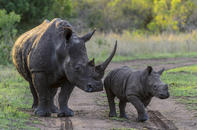Mud Baths
White rhino are fond of wallowing in mud in order to help them cope with excessive summer heat conditions. A good caking of mud prevents sunburn and keeps a layer of moisture close to the skin to assist with keeping cool. The mud once dried also acts as a parasite-removing wax treatment that the rhino will rub free of their skin against trees, rocks or termite mounds.

Rhinos are prone to reusing their rubbing posts that eventually become quite smooth and polished. They may also use these posts to scratch in hard to reach areas such as the inner legs and belly. While they wallow in the mud, terrapins will also pluck parasites off the rhino’s hide.
White rhino are active throughout both the day and night and spend at least half their time feeding in order to satisfy the nutritional demands of their huge bodies. They prefer to rest during the heat of the day which they will do under the cover of dense bush.
They also take refuge in thickets should the weather turn particularly cold or windy. When they sleep they do so relatively soundly breathing heavily. During sleep, the ears may be seen instinctively flicking in all directions and rhino can react to disturbing sounds with impressive speed if the need arises.
Don’t Crash the Party

The collective noun for a group of rhino is appropriately ‘a crash of rhino’. Although they seem quite ungainly, rhino are able to charge at a speed of 40 kmph if they need to. White rhinos that are stressed will perform displacement behaviour. This may take the form of curling up the tail, a nervous bouncy gait around the same spot, turning side on to the disturbance or rubbing the horn on the ground. Cows with young are especially protective. When a cow and her offspring flee from danger, the calf always runs ahead.
Red-billed oxpeckers are almost always in attendance of rhinos. They glean ticks and other parasites off the skin of the rhino supplying themselves with a meal and their hosts with a free grooming session.
The oxpeckers also perform the useful service of warning the sight-impaired rhinos of approaching threats flying up noisily when disturbed. Oxpeckers can also be a useful indication to humans of the presence of rhino nearby.
By Megan Emmett